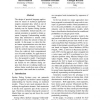3185 search results - page 86 / 637 » Principles for modeling language design |
KES
2008
Springer
13 years 7 months ago
2008
Springer
This paper presents a user interface to the User-Centred Knowledge Model (t-UCK). T-UCK is a knowledge modelling tool for designing knowledge-intensive systems. The model centres r...
EMNLP
2009
13 years 5 months ago
2009
The design of practical language applications by means of statistical approaches requires annotated data, which is one of the most critical constraint. This is particularly true f...
SBMF
2010
Springer
13 years 2 months ago
2010
Springer
Designers of concurrent and distributed algorithms usually express them using pseudo-code. In contrast, most verification techniques are based on more mathematically-oriented forma...
EMSOFT
2006
Springer
13 years 11 months ago
2006
Springer
We describe a simple scheme for mapping synchronous language models, in the form of Boolean Mealy Machines, into timed automata. The mapping captures certain idealized implementat...
PERCOM
2007
ACM
14 years 7 months ago
2007
ACM
The Context Modelling Language (CML), derived from Object Role Modeling (ORM), is a powerful approach for capturing the pertinent object types and relationships between those type...

